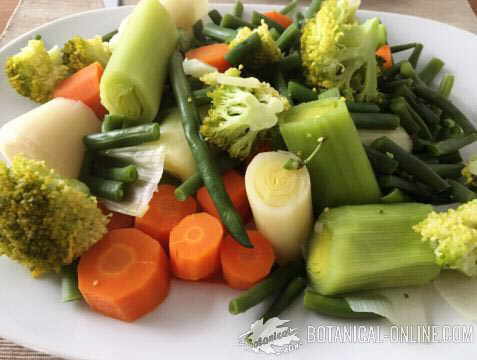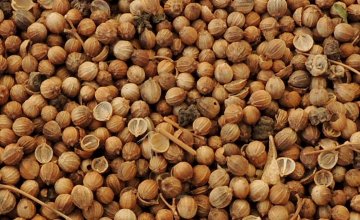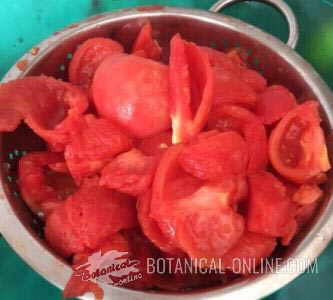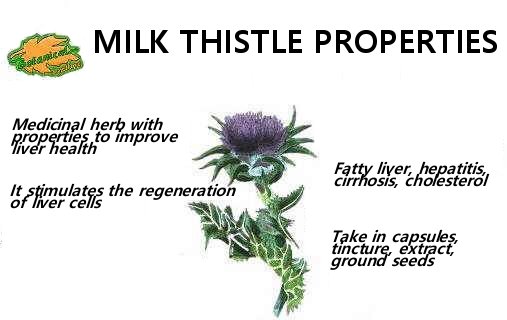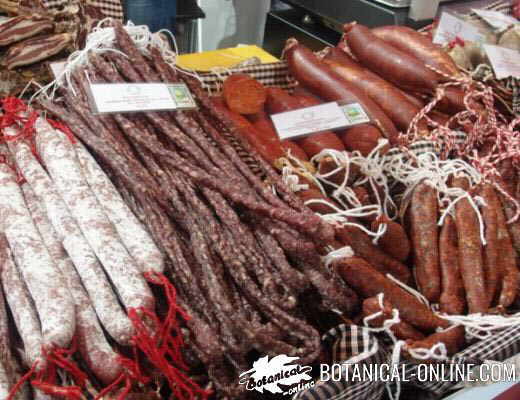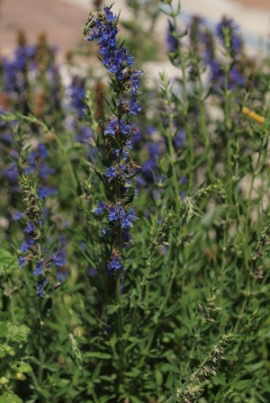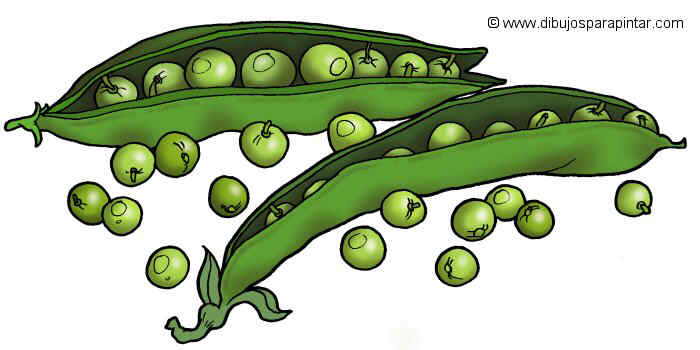Contents
Composition of rhubarb and properties in the kitchen
RHUBARB AS FOOD
How to cook rhubarb
There are different varieties of rhubarb, among which garden rhubarb (Rheum rhabarbarum) is used and marketed for food purposes.
There are other varieties of rhubarb that are mainly used for medicinal purposes, and their parts used for this purpose are their dried rhizomes. Among these medicinal plants stands the Chinese rhubarb (Rheum palmatum).
IMPORTANT. Before we start to cook the rhubarb (Rheum rhabarbarum) we must know that not all the leaf is edible. The edible part of this plant is the petiole of each leaf (popularly called “stem”), that is reddish-green or deep red.
Leaf blade contains TOXIC substances and it is NOT edible.
– More information on the toxic effects of intake of rhubarb leaves.
Nutritional composition of garden rhubarb
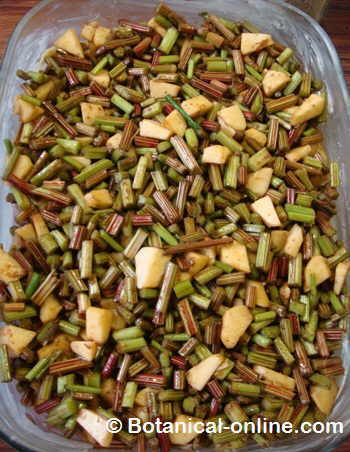 Photo of rhubarb with apple, prepared to make a dessert. |
- Carbohydrates: Rhubarb has a low carbohydrate intake, similar to other vegetables, so it is suitable in diets for diabetes because of its low glycemic index.
- Proteins: the protein supply of this vegetable is practically insignificant, so we must accompany it with other protein foods.
- Fats: petioles of rhubarb are vegetables with low fat content, so they are healthy to include in diets that require low fat content and good contribution of nutrients, as in diets for cardiovascular health. Olive oil is the best ally to dress up this delicious vegetable.
- Fiber: it is the most prominent component after its sugars. Among its fibrous content, there is pectin, a type of fiber regulating intestinal transit.
Mixing it with water, makes it acquire a gelatinous consistency. This type of fiber is the one that most fruits contain and the one that provides you with thicker plates and jams.
- Vitamins: We must emphasize its content in vitamin A, in the form of alpha tocopherol and betacarotenes. It also contains vitamin C, thiamine and riboflavin.
- Minerals: due to its high content of potassium and its low sodium intake, it is a diuretic plant, indicated for the retention of liquids. It also contains iron, selenium, zinc and manganese.
- Acids: oxalic acid, acetic acid, caffeic acid, citric acid, coumaric acid, ferulic acid, gallic acid, malic acid, synapic acid, succinic acid, vanillic acid.
- Anthraquinone glycosides (leaf). These compounds are associated with the toxic potential of rhubarb leaf (blade) intake and at the same time its laxative effects when consumed in medium doses.
- Flavonoids: rutin, lutein, cyanidin.
- Tannins (5-10%) (rhizome): catechins, epicatechins, gallocatechins. The high content of tannins gives it astringent properties when consumed in low doses.
PROPERTIES OF RHUBARB
Rhubarb for slimming
Rhubarb is a very fibrous vegetable with high satiating power. It contains few calories, sugars and no fat content. Therefore, it is very suitable for slimming or dieting to lose weight.
Some have attributed to this food slimming properties, because consumed in medium amounts, rhubarb petioles contain laxative compounds. These laxative compounds are the glycosides of anthraquinones.
Anthraquinones are highly irritating and act by stimulating the nerve fibers and causing the intestines to increase their movements, so they have a cathartic effect (they accelerate the rate of deposition). When we increase defecation, we are preventing some nutrients, like fats, to be absorbed in case of having made a meal very rich in fats.
However, anthraquinone glycosides are compounds that, in large amounts, are irritant and toxic. They are only found in these amounts in the blade of the leaf, so we should only consume the rhubarb petioles (“stems”). These compounds are also found in lesser amounts in laxative plants such as the cascara sagrada and senna, vey known laxatives in phytotherapy.
Rhubarb to fight constipation and diarrhea
Rhubarb is a plant that responds in one way or another depending on the amount used. Due to its high content of anthraquinone glycosides and tannins, in low amounts, rhubarb is slightly astringent, and even suitable for treating diarrhea.
Instead, when consumed in moderate amounts, rhubarb is an effective laxative meal.
* More information of Rhubarb medicinal properties.
Cooking with rhubarb
Rhubarb (Rheum rhabarbarum) has a fleshy vegetable texture that gives us much fiber and many vitamins and minerals with low caloric content. Therefore, this vegetable is ideal for enriching any healthy diet as a contribution of fiber, for people with Diabetes because of its low glycemic index, and for people on slimming diets.
Many culinary applications highlight the property of rhubarb (Rheum rhabarbarum) to prepare sweet dishes with fruits due to their content in sugar, citric acid and malic acid. These give it an excellent flavor that combines with strawberries, apples and all kinds of fleshy fruits. In addition, because of its water content and soluble pectin fiber, if we add sugar to this vegetable, we can be made delicious jams or cakes fillings.
Another culinary application for rhubarb petioles is to introduce them in our usual dishes, such as salads, soups, stews or other preparations in the oven. The more we cook it, the better and sweeter it will taste.
* Related information: Rhubarb recipes
Tips on rhubarb in the kitchen
To cook rhubarb, we must take into account its high content of oxalic acid.
Oxalic acid or oxalates are substances present in many plants, such as spinach, cocoa or beets, which when combined, combine with calcium to prevent digestion and causing a deficit of this mineral. It has been shown that a diet very rich in oxalates can cause renal lithiasis, which is popularly known as stones in the kidney. For the same reason, rhubarb is not suitable in the diet of people with osteoarthritis or arthritis.
- Scald or boil the petioles (“stems”) of rhubarb. In this way we will reduce its content in oxalic acid. The water resulting from cooking must be discarded.
- Combine rhubarb with calcium-rich foods. For example, cook the rhubarb inside quiches with cream or cheese, in salads with fresh cheese, combined with citrus in desserts and jams, or simply taking a dairy dessert.
| Composition of leaves stems of rhubarb per 100g | |
| Nutrient | Amount |
| Water (g) | 93,61 |
| Calories (Kcal) | 21 |
| Carbohydrates (g) | 4,54 |
| Proteins (g) | 0,90 |
| Fats (g) | 0,20 |
| Fiber (g) | 1,80 |
| Vitamin A (UI) | 100 |
| Vitamin E (mg.) | 0,20 |
| Vitamin C (mg.) | 8 |
| Vitamin B1 or thiamin (mg.) | 0,02 |
| Vitamin B2 or riboflavin (mg.) | 0,03 |
| Vitamin B3 or niacin (mg.) | 0,30 |
| Vitamin B5 or pantothenic acid (mg.) | 0,09 |
| Vitamin B6 or pyridoxin (mg.) | 0,02 |
| Folate (mcg.) | 7 |
| Calcium (mg.) | 86 |
| Magnesium (mg.) | 12 |
| Phosphorus (mg.) | 14 |
| Sodium (mg.) | 4 |
| Potassium (mg.) | 288 |
| Iron (mg.) | 0,22 |
| Zinc (mg.) | 0,10 |
| Manganese (mg.) | 0,20 |
![]() More information on rhubarb.
More information on rhubarb.

